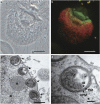Genome of 'Ca. Desulfovibrio trichonymphae', an H2-oxidizing bacterium in a tripartite symbiotic system within a protist cell in the termite gut
- PMID: 27801909
- PMCID: PMC5322295
- DOI: 10.1038/ismej.2016.143
Genome of 'Ca. Desulfovibrio trichonymphae', an H2-oxidizing bacterium in a tripartite symbiotic system within a protist cell in the termite gut
Abstract
The cellulolytic protist Trichonympha agilis in the termite gut permanently hosts two symbiotic bacteria, 'Candidatus Endomicrobium trichonymphae' and 'Candidatus Desulfovibrio trichonymphae'. The former is an intracellular symbiont, and the latter is almost intracellular but still connected to the outside via a small pore. The complete genome of 'Ca. Endomicrobium trichonymphae' has previously been reported, and we here present the complete genome of 'Ca. Desulfovibrio trichonymphae'. The genome is small (1 410 056 bp), has many pseudogenes, and retains biosynthetic pathways for various amino acids and cofactors, which are partially complementary to those of 'Ca. Endomicrobium trichonymphae'. An amino acid permease gene has apparently been transferred between the ancestors of these two symbionts; a lateral gene transfer has affected their metabolic capacity. Notably, 'Ca. Desulfovibrio trichonymphae' retains the complex system to oxidize hydrogen by sulfate and/or fumarate, while genes for utilizing other substrates common in desulfovibrios are pseudogenized or missing. Thus, 'Ca. Desulfovibrio trichonymphae' is specialized to consume hydrogen that may otherwise inhibit fermentation processes in both T. agilis and 'Ca. Endomicrobium trichonymphae'. The small pore may be necessary to take up sulfate. This study depicts a genome-based model of a multipartite symbiotic system within a cellulolytic protist cell in the termite gut.
Conflict of interest statement
The authors declare no conflict of interest.
Figures





Similar articles
-
'Candidatus Ancillula trichonymphae', a novel lineage of endosymbiotic Actinobacteria in termite gut flagellates of the genus Trichonympha.Environ Microbiol. 2012 Dec;14(12):3259-70. doi: 10.1111/1462-2920.12012. Epub 2012 Nov 1. Environ Microbiol. 2012. PMID: 23116209
-
Comparison of Intracellular "Ca. Endomicrobium Trichonymphae" Genomovars Illuminates the Requirement and Decay of Defense Systems against Foreign DNA.Genome Biol Evol. 2016 Oct 13;8(10):3099-3107. doi: 10.1093/gbe/evw227. Genome Biol Evol. 2016. PMID: 27635050 Free PMC article.
-
Parallel reductive genome evolution in Desulfovibrio ectosymbionts independently acquired by Trichonympha protists in the termite gut.ISME J. 2020 Sep;14(9):2288-2301. doi: 10.1038/s41396-020-0688-1. Epub 2020 Jun 1. ISME J. 2020. PMID: 32483307 Free PMC article.
-
[Symbiotic complex in the termite gut microbial community].Tanpakushitsu Kakusan Koso. 2008 Nov;53(14):1841-9. Tanpakushitsu Kakusan Koso. 2008. PMID: 19044020 Review. Japanese. No abstract available.
-
Towards an integrated understanding of the consequences of fungus domestication on the fungus-growing termite gut microbiota.Environ Microbiol. 2015 Aug;17(8):2562-72. doi: 10.1111/1462-2920.12765. Epub 2015 Mar 6. Environ Microbiol. 2015. PMID: 25581852 Review.
Cited by
-
Gut microbiota dynamics and functionality in Reticulitermes grassei after a 7-day dietary shift and ciprofloxacin treatment.PLoS One. 2018 Dec 27;13(12):e0209789. doi: 10.1371/journal.pone.0209789. eCollection 2018. PLoS One. 2018. PMID: 30590374 Free PMC article.
-
Phylogenetic Diversity and Single-Cell Genome Analysis of "Melainabacteria", a Non-Photosynthetic Cyanobacterial Group, in the Termite Gut.Microbes Environ. 2018 Mar 29;33(1):50-57. doi: 10.1264/jsme2.ME17137. Epub 2018 Mar 8. Microbes Environ. 2018. PMID: 29415909 Free PMC article.
-
A unique symbiosome in an anaerobic single-celled eukaryote.Nat Commun. 2024 Nov 9;15(1):9726. doi: 10.1038/s41467-024-54102-7. Nat Commun. 2024. PMID: 39521804 Free PMC article.
-
Genome Analysis of a Verrucomicrobial Endosymbiont With a Tiny Genome Discovered in an Antarctic Lake.Front Microbiol. 2021 Jun 1;12:674758. doi: 10.3389/fmicb.2021.674758. eCollection 2021. Front Microbiol. 2021. PMID: 34140946 Free PMC article.
-
Revealing the metabolic capacity of Streblomastix strix and its bacterial symbionts using single-cell metagenomics.Proc Natl Acad Sci U S A. 2019 Sep 24;116(39):19675-19684. doi: 10.1073/pnas.1910793116. Epub 2019 Sep 6. Proc Natl Acad Sci U S A. 2019. PMID: 31492817 Free PMC article.
References
-
- Badziong W, Ditter B, Thauer RK. (1979). Acetate and carbon dioxide assimilation by Desulfovibrio vulgaris (Marburg), growing on hydrogen and sulfate as sole energy source. Arch Microbiol 123: 301–305.
-
- Brune A. (2014). Symbiotic digestion of lignocellulose in termite guts. Nat Rev Microbiol 12: 168–180. - PubMed
-
- Cypionka H. (2000). Oxygen respiration by Desulfovibrio species. Annu Rev Microbiol 54: 827–848. - PubMed
MeSH terms
LinkOut - more resources
Full Text Sources
Other Literature Sources
Molecular Biology Databases

